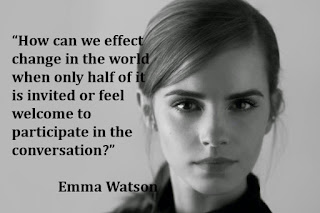"Normal"
“How
do our earliest body images form in the first place” (24, Dueling Dualism)
Fausto-Sterling imposes this seemingly
simple, yet mind blowing question in her book, Sexing the Body. I have never really thought about how my earliest
body image of myself formed, but I would say that it was influenced from women
in the media and TV shows—as I never had a woman in my house to influence my
image. Another interesting and important concept Fausto-Sterling introduces, originally
popularized by Ehrhardt, that “sex and gender are separate categories”. This is
an important distinction to make because people do not always identify with their
biological sex. Give for example, Maria Patiño, who as described in the book,
was eliminated from competing in the 1988 Olympics because she had failed the
sex test due to the fact she had neither ovaries nor a uterus, even though she
looked and identified as a female. Intersex people, such as Patiño, face
stigmatized gender identities because they do not “fit” into what our society
deems as “normal” definitions and categorizations of sex and gender.
Traditional distinctions and social constructs of gender and sex are to blame,
because as Fausto-Sterling explains, sex is not either/or (3). Further, Intersex
newborns are treated as either/or scenarios and viewed as resulting from “fundamentally
abnormal processes”, according to psychologist John Money (46).
Fausto-Sterling’s point of view is very
interesting because she discusses sex and gender as a biologist who uses her
trade in hopes of re-constructing societies view of sex and gender. I found the
figures she includes of the anatomies of females and males to be fascinating,
mixed with her explanation of embryonic gonads, which ultimately decide the sex
of the child (50). When talking about
the history of constructing sex and gender as depicted in figure 1.1, a scientist
exclaims to his partner, “there are six categories, but why? There’s got to be
a clue here!”, as he examines human brains. Fausto-Sterling points out the flaw
behind this reasoning, the scientists are making categories first and then are
searching for clues from there to support their claims. From a statistical
point of view, this argument should be completely disregarded as correct
because by categorizing first, then looking for clues, there is a lot of
confirmation bias.
Fausto-Sterling’s argument that sex and
gender are social constructions and the example of Patiño being eliminated from
the Olympics reminds me of a similar argument Simone de Beauvoir, a French feminist
author and philosopher, makes in her controversial book, “The Second Sex”: the allegation that women were inferior to
men, hence labeled the “second sex.” Not only this, but Beauvoir also noticed the inequity between
the gender roles and how men often referred to women as the "Other,"
suggesting that women were not considered men’s
equals. Fausto-Sterling would argue that because of the categorization in today’s
society based off of what is “normal”, then intersex people, would be
considered as “Other”. Facing similar inequities that Beauvoir describes as
being seen as unequal and lesser.
- Jane B




Comments
Post a Comment